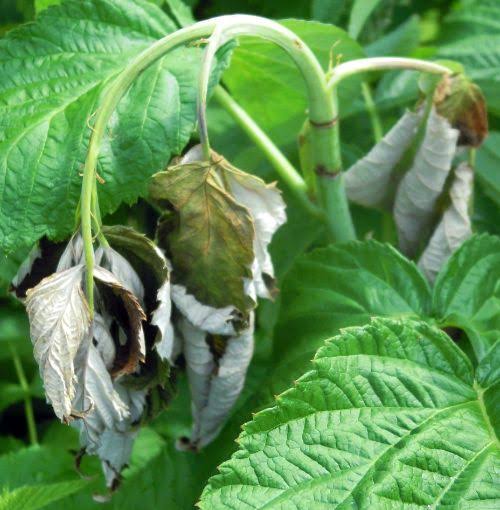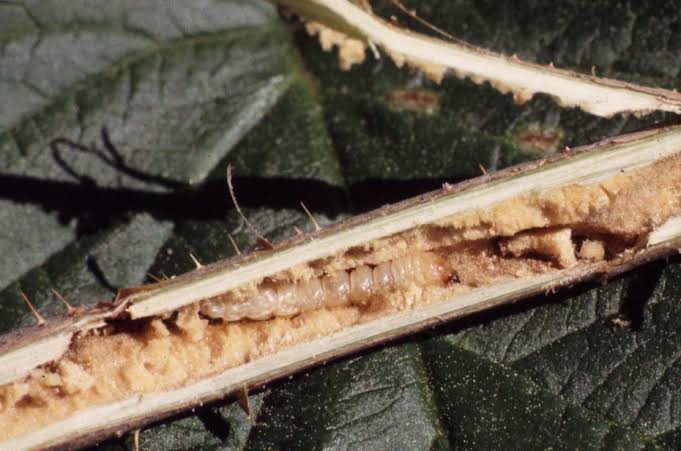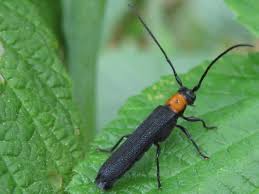Raspberry Cane Borers scientifically known as Oberea bimaculata are insects that can cause significant damage to raspberry plants. These pests are a type of longhorn beetle and are known for their distinctive black and yellow coloring. Understanding the life cycle and habits of Raspberry Cane Borers is crucial for effective pest management in raspberry cultivation.
The adult Raspberry Cane Borer is approximately half an inch long, with two yellow spots on its black body. These beetles typically emerge in late spring or early summer. During this time, they are most active and lay eggs on the canes of raspberry plants. The female beetles use their sharp ovipositor to insert eggs into the soft tissue of the canes.
Once the eggs hatch, the larvae bore into the raspberry canes, causing damage as they feed on the inner tissues. This feeding activity weakens the canes, making them susceptible to breakage and disease. The larvae undergo several stages of development within the canes, and their presence is often not apparent until the damage becomes severe.
Infestations by Raspberry Cane Borers can lead to reduced raspberry yields and compromised plant health. It is essential for raspberry growers to monitor their plants regularly for signs of infestation, such as wilting or dieback of canes. Pruning and removing infested canes can help mitigate the spread of these pests.
In terms of management strategies, applying insecticides at the appropriate times in the beetle’s life cycle can be an effective control measure. Additionally, maintaining proper cultural practices, such as pruning and disposing of infested canes, can help reduce the overall population of Raspberry Cane Borers.
Raspberry Cane Borers pose a threat to raspberry plants, impacting both yield and plant health. Vigilant monitoring and timely intervention through cultural practices and targeted insecticide application are crucial for managing and preventing infestations. By understanding the life cycle and habits of these pests, raspberry growers can adopt proactive measures to protect their crops and ensure a healthy harvest.
Read Also: How to Grow, Use and Care for Woodrush Grass (Luzula spp.)
Plants Affected by Raspberry Cane Borers (Oberea bimaculata)

Raspberry cane borers primarily affect raspberry plants (Rubus idaeus), which are members of the rose family (Rosaceae). These pests specifically target the canes of raspberry plants, causing damage through their feeding activities. The larvae bore into the canes, compromising their structural integrity and leading to a range of issues such as wilting, dieback, and increased vulnerability to diseases.
The susceptibility of raspberry plants to cane borer infestations underscores the importance of monitoring and implementing effective pest management strategies to safeguard the health and productivity of raspberry crops. Proper care, including pruning and timely removal of infested canes, plays a crucial role in mitigating the impact of raspberry cane borers on these plants.
Beyond raspberries, it’s worth noting that some other plants within the broader Rubus genus, which includes various brambles and berries, may also be susceptible to raspberry cane borers. These can include blackberries and other related species.
The potential impact on different plants within the Rubus genus highlights the importance of a comprehensive approach to pest management. Raspberry cane borers are not selective solely to one type of berry plant, and their presence can pose a threat to overall berry cultivation.
Cultivators and gardeners cultivating berries should remain vigilant, regularly inspecting plants for any signs of infestation. Early detection is key to minimizing the damage caused by these borers. Implementing integrated pest management strategies, which may include the use of insecticides, cultural practices, and biological controls, can be essential in mitigating the risk of infestation and protecting a variety of berry crops.
While raspberry plants are the primary targets of Raspberry Cane Borers, other members of the Rubus genus, such as blackberries, may also be at risk. A holistic and proactive approach to pest management is crucial for maintaining the health and productivity of berry crops, ensuring a bountiful harvest for growers and gardeners alike.
Damages Caused by Raspberry Cane Borers

Raspberry cane borers can inflict various damages on raspberry plants, affecting both the yield and overall health of the crop. The primary mode of damage stems from the life cycle of these pests, involving their larvae boring into the canes. Here are some notable impacts:
1. Cane Weakening: The larvae of Raspberry Cane Borers tunnel into the canes, compromising their structural integrity. This weakening of the canes makes them more susceptible to breakage, especially during periods of wind or heavy fruit loads.
2. Wilting and Dieback: Infested canes often exhibit wilting and dieback symptoms. As the larvae feed on the inner tissues of the canes, they disrupt the flow of nutrients, leading to the decline of affected portions of the plant. This can result in reduced vigor and stunted growth.
3. Reduced Yield: Weakened and infested canes may produce fewer and lower-quality berries. The overall yield of the raspberry crop can be significantly impacted as a result of the compromised health of the plant and the reduced capacity to bear fruit.
4. Increased Vulnerability to Diseases: The wounds created by Raspberry Cane Borers provide entry points for pathogens, increasing the susceptibility of raspberry plants to various diseases. This secondary impact can further exacerbate the overall decline in plant health.
5. Stress on the Plant: The presence of Raspberry Cane Borers induces stress on the raspberry plant. Stressed plants are more susceptible to environmental factors, such as extreme weather conditions, and may struggle to recover from other stressors.
Addressing and mitigating these damages require timely intervention and proactive pest management practices. Regular monitoring, pruning of infested canes, and implementing effective control measures are essential to minimize the negative effects of Raspberry Cane Borers on raspberry cultivation.
Read Also: How to Grow, Use and Care for Woolfruit Sedge Grass (Carex lasiocarpa)
Control and Preventive Measures

Effective control and preventive measures are crucial for managing Raspberry Cane Borers and safeguarding raspberry plants. Here are several strategies that growers can employ:
1. Monitoring and Early Detection: Regularly inspect raspberry plants for signs of infestation, such as wilting, dieback, or entry holes in the canes. Early detection allows for prompt action before the infestation becomes severe.
2. Pruning and Removing Infested Canes: Prune and dispose of canes showing signs of infestation. This helps remove the larvae and prevents them from completing their life cycle. Proper disposal, such as burning or removing from the area, can further reduce the risk of reinfestation.
3. Cultural Practices: Adopt good cultural practices to promote plant health. This includes providing adequate nutrition, maintaining proper spacing between plants for air circulation, and ensuring optimal soil moisture.
4. Insecticides: Consider the targeted use of insecticides, applied at the appropriate times in the life cycle of Raspberry Cane Borers. Consult with local agricultural extension services or experts for guidance on suitable and safe insecticide options.
5. Biological Controls: Encourage natural predators and parasitoids that feed on Raspberry Cane Borers. Beneficial insects, such as parasitic wasps, can help keep pest populations in check.
6. Crop Rotation: Avoid planting raspberries in the same location year after year. Crop rotation can disrupt the life cycle of pests and reduce the likelihood of infestation.
7. Trap Crops: Introduce trap crops, which are plants that attract pests away from the main crop. This method can be used strategically to divert Raspberry Cane Borers and reduce their impact on raspberry plants.
8. Barriers: Consider physical barriers, such as row covers, to prevent adult beetles from laying eggs on raspberry canes. This method can be particularly effective in small-scale or home garden settings.
9. Clean Garden Practices: Maintain a clean and weed-free garden environment. Weeds and debris can provide hiding places for pests, so keeping the area tidy can help reduce the attractiveness of the environment for Raspberry Cane Borers.
By combining these control and preventive measures, growers can create a more resilient and pest-resistant environment for raspberry plants, minimizing the impact of Raspberry Cane Borers on both yield and plant health.
Frequently Asked Questions (FAQs) About Raspberry Cane Borers (Oberea bimaculata)
Q1: What are Raspberry Cane Borers, and what do they look like?
Raspberry Cane Borers are insects scientifically known as Oberea bimaculata. They are longhorn beetles with a distinctive black and yellow coloring. Adults are approximately half an inch long and have two yellow spots on their bodies.
Q2: How do Raspberry Cane Borers damage raspberry plants?
Raspberry Cane Borers damage raspberry plants by laying eggs on the canes. Once the eggs hatch, the larvae bore into the canes, weakening them and causing wilting, dieback, and reduced yield. The feeding activity also makes the canes more susceptible to diseases.
Q3: When is the most active period for Raspberry Cane Borers?
Raspberry Cane Borers are most active during late spring or early summer when adults emerge and lay eggs on raspberry canes.
Q4: What are the signs of Raspberry Cane Borer infestation?
Signs of infestation include wilting, dieback, and entry holes in raspberry canes. Infested canes may break more easily, and overall plant vigor may decline.
Q5: How can I prevent Raspberry Cane Borer infestations?
Preventive measures include regular monitoring, pruning and removing infested canes, adopting good cultural practices, using targeted insecticides, encouraging natural predators, and practicing crop rotation.
Q6: Are Raspberry Cane Borers only a threat to raspberries?
While raspberries are the primary targets, other plants within the Rubus genus, such as blackberries, may also be susceptible to Raspberry Cane Borer infestations.
Q7: Can I use organic methods to control Raspberry Cane Borers?
Yes, organic methods include introducing beneficial insects, practicing good garden hygiene, using physical barriers, and employing biological controls. Consult with organic gardening resources for suitable options.
Q8: How should I dispose of infested canes?
Infested canes should be pruned and either burned or removed from the area to prevent reinfestation.
Q9: Can Raspberry Cane Borers be controlled without using chemicals?
Yes, cultural practices, biological controls, and preventive measures can be effective without resorting to chemical insecticides. However, the approach may vary based on the severity of the infestation and the specific conditions of the raspberry planting.
Q10: What should I do if I suspect a Raspberry Cane Borer infestation?
If you suspect an infestation, inspect the canes for signs of damage, remove and dispose of infested canes, and consider implementing preventive measures. For severe cases, consult with local agricultural experts for tailored advice.
Read Also: How Long Does It Take a Hazelnut Tree to Produce Nuts?
